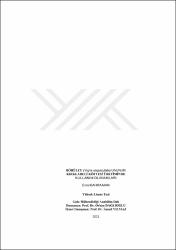| dc.contributor.advisor | Dağlıoğlu, Orhan | |
| dc.contributor.advisor | Yılmaz, İsmail | |
| dc.contributor.author | Kahraman, Esra | |
| dc.date.accessioned | 2022-04-06T06:49:24Z | |
| dc.date.available | 2022-04-06T06:49:24Z | |
| dc.date.issued | 2021 | |
| dc.identifier.uri | https://tez.yok.gov.tr/UlusalTezMerkezi/TezGoster?key=RjZwH00oMG4iNa5Sgvlgg6-vshpiWRxd7GdzvsBiWJFK2KdAVphvjCDmhwHYiWBj | |
| dc.identifier.uri | https://hdl.handle.net/20.500.11776/4096 | |
| dc.description.abstract | Tez çalışmasında; börülce (Vigna unguiculata) ununun Kırklareli köftesinin bazı fiziksel, kimyasal, tekstürel ve duyusal özellikleri üzerindeki etkileri araştırılmıştır. Bu amaçla, geleneksel Kırklareli köftesi formülasyonuna dört farklı oranda (%2, %4, %6 ve %8) börülce unu ilave edilmiştir. Çiğ ve pişmiş köfte örneklerinin fiziksel, kimyasal ve tekstürel özellikleri ile pişmiş örneklerin duyusal özellikleri incelenmiştir. Ayrıca, börülce ununun fiziksel ve kimyasal özellikleri de analiz edilmiştir. Köfte formülasyonunda börülce unu oranı arttıkça örneklerin su aktivitesi (aw), nem, yağ, serbest yağ asidi ve tuz değerlerinin azaldığı; pH, protein, kül, karbonhidrat, toplam diyet lifi ve tekstür değerlerinin arttığı belirlenmiştir. Köfte örneklerinin yağ asitleri kompozisyonunda oleik asidin (çiğ örneklerde %35,82-%36,96; pişmiş örneklerde %36,89-%37,92) en yüksek değere sahip olduğu, bunu sırasıyla palmitik (çiğ örneklerde %25,88-%27,08; pişmiş örneklerde %25,92-%27,50) ve stearik asitlerin (çiğ örneklerde %22,11-%23,89; pişmiş örneklerde %23,62-%23,91) izlediği saptanmıştır. Börülce unu ilavesi çiğ Kırklareli köftesi örneklerinin renk (L* değeri 43,40-53,88 ve b* değeri 13,92-18,11), pH (5,83-5,94), su aktivitesi (0,96-0,98), nem (%44,03-%50,63), protein (%17,70-%21,89), yağ (%19,49-%22,97), karbonhidrat (%6,77-%12,11), tuz (%1,28-%1,74) ve toplam diyet lifi (%2,81-%5,08) değerlerinde; pişmiş Kırklareli köftesi örneklerinin ise renk (a* değeri 5,64-9,44 ve b* değeri 9,77-18,06), nem (%39,27-%45,24), protein (%19,92-%23,45), yağ (%23,08-%26,19), karbonhidrat (%5,92-%11,30) ve toplam diyet lifi (%3,28-%5,40) değerlerinde istatistiksel olarak önemli farklılıklar (p<0,05) oluşturmuştur. Buna karşın börülce unu kullanımı, köfte örneklerinin ağırlık kaybı, kül, serbest yağ asidi, tekstür ve duyusal analiz değerlerinde istatistiksel olarak anlamlı bir fark (p>0,05) oluşturmamıştır. Duyusal analizde, börülce unu ilave edilmiş örnekler arasında en fazla beğeniyi %4 börülce unu ilaveli köfte örneği almıştır. Elde edilen veriler, Kırklareli köftesi üretiminde tekstürel ve duyusal özellikleri hissedilir düzeyde etkilemeden börülce ununun %4 oranına kadar ilave edilebileceğini ortaya koymuştur. | en_US |
| dc.description.abstract | In this research; the effects of cowpea (Vigna unguiculata) flour on some physical, chemical, textural and sensory properties of Kırklareli meatballs were investigated. For this purpose, cowpea flour was added to the traditional Kırklareli meatball formulation in four different proportions (2%, 4%, 6% and 8%). Physical, chemical and textural properties of raw and cooked meatball samples and sensory properties of cooked samples were investigated. In addition, physical and chemical properties of cowpea flour were analyzed. In the meatball formulation, as the cowpea flour proportion increased, the water activity (aw), moisture, fat, free fatty acidity and salt values of the samples decreased; it was determined that pH, protein, ash, carbohydrate, total dietary fiber and texture values increased. Oleic acid (35,82%-36,96% in the raw samples; 36,89%-37,92% in the cooked samples) had the highest value in the fatty acid composition of meatball samples, followed by palmitic (25,88%-27,08% in the raw samples; 25,92%-27,50% in the cooked samples) and stearic (22,11%-23,89% in the raw samples; 23,62%-23,91% in the cooked samples) acids. The addition of cowpea flour resulted in significant differences (p<0,05) in the color (L* value 43,40-53,88 and b* value 13,92-18,11), pH (5,83-5,94), water activity (0,96-0,98), moisture (44,03%-50,63%), protein (17,70%-21,89%), fat (19,49%-22,97%), carbohydrate (6,77%-12,11%), salt (1,28%-1,74%) and total dietary fiber (2,81%-5,08%) values of the raw Kırklareli meatball samples and the color (a* value 5,64-9,44 and b* value 9,77-18,06), moisture (39,27%-45,24%), protein (19,92%-23,45%), fat (23,08%-26,19%), carbohydrate (5,92%-11,30%) and total dietary fiber (3,28%-5,40%) values of the cooked Kırklareli meatball samples. On the other hand, the use of cowpea flour did not make a statistically significant difference (p>0,05) in the weight loss, ash, free fatty acidity, texture and sensory analysis values of the meatball samples. In the sensory analysis, meatballs with 4% cowpea flour received the highest acceptability score among the samples with added cowpea flour. According to the data obtained that cowpea flour can be added up to 4% without affecting the textural and sensory properties of Kırklareli meatballs. | en_US |
| dc.language.iso | tur | en_US |
| dc.publisher | Tekirdağ Namık Kemal Üniversitesi | en_US |
| dc.rights | info:eu-repo/semantics/openAccess | en_US |
| dc.subject | Gıda Mühendisliği | en_US |
| dc.subject | Food Engineering | en_US |
| dc.title | Börülce (Vigna unguiculata) ununun Kırklareli köftesi üretiminde kullanım olanakları | en_US |
| dc.title.alternative | Possibility of using cowpea (Vigna unguiculata) flour in Kirklareli meatball production | en_US |
| dc.type | masterThesis | en_US |
| dc.department | Enstitüler, Fen Bilimleri Enstitüsü, Gıda Mühendisliği Ana Bilim Dalı | en_US |
| dc.identifier.startpage | 1 | en_US |
| dc.identifier.endpage | 108 | en_US |
| dc.institutionauthor | Kahraman, Esra | |
| dc.relation.publicationcategory | Tez | en_US |
| dc.identifier.yoktezid | 700126 | en_US |



















